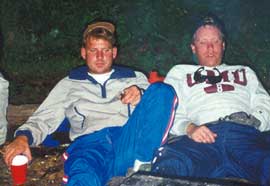|
Trip Notes:
Jim and I drove up first to the put-in at Kawishiwi
Lake at the end of Sawbill and arrived late
at night. It rained pretty decently, so Jim
and I set up camp in the back of Big Blue and
turned on the interior topper lights. The rest
of the crew arrived around midnight and promptly
made the back of Big Blue seem pretty tiny.
We pushed off pretty
early, around 7:00am, and paddled into a slight
morning headwind across Kawishiwi Lake about
2 miles to the first portage. We headed north
across the next lake as the wind picked up,
to our longest portage of the trip (about 1/4
mile). Then we headed into a pretty big lake
and Jim and I were the heaviest guys in the
slowest canoe, so we had to beat ass just to
keep up. After the third portage, we were out
of the wind and on our designated lake (Koma)
that Drew had picked out. Not a soul was on
any of the camping areas, so we had the pick
of the crop. It was about 800 yards north of
the last portage...a series of beaver dams at
that river portage providing random firewood
for the taking.
Two days in, Drew
came up with the plan to paddle to the headwaters
of the Kawishiwi River, where the famous Pictographs
were located. I REALLY wanted to see them, so
I helped rally the troops. It was a 10.5 mile
paddle there from our base camp, so we took
extra emergency gear, food and a water filter
and fished on the way.
It was quite a
journey, through some sheer-wall, narrow Basalt
canyons that topped out at 60 feet as we rounded
the north bend of the route and started heading
south. The channel was only 50 feet wide at
some points, and very deep. There was a series
of several short portages that made it easier
to just leave the canoes loaded "as is"
and just put a man on each end and hump them
the 200 yards or so to the other side. When
we finally got to the headwaters of the Kawishiwi
River, it was a pretty nasty elevation drop
through some rocky terrain to the start of the
Kawishiwi River below. We left all of our emergency
and backup gear at the top of the portage and
brought just canoes and fishing gear down and
put back in below the falls.
After ga-gawing
at the incredibly ancient 800-year-old-plus
Woodland Indian Pictographs on the overhanging
walls below the falls, someone dropped a line
in the water and hit a fish on the first cast.
It turned out to be a pool of very hungry walleye
and Northern Pike at the terminus up the river.
We caught and released about 50 fish between
us for nearly an hour until we ran out of bait.
Drew caught two walleyes on a dry hook after
the bait ran out.
Time was marching
on, and we had a 10.5-mile paddle home, so we
packed up and went back up the portage with
our canoes. At the top of the falls, the fishermen
of the group figured it would be worthwhile
to try that terminus as well. Ho-Ho!!! Fish
on, on just about every cast. That photo above
of Jimmers landing that Northern was at the
top of the falls. We finally just had to leave,
and started the paddle home.
Drew and I were
the cheerleaders of paddling all the way to
this destination, and we heard grumbles from
the crew on the way back. We left basecamp at
around 8:30am, and it took us all day and into
sunset to get back. That photo of Jim paddling
out of the sunset above was taken on the sunset
trip back. People were complaining, yes, but
I think everyone enjoyed the extreme extra effort
that went into that really long day trip.
Overall, I will
conclude this: I was the 8th guy in a group
of 8 serious Fishermen who was NOT a fisherman.
I came out of the trip knowing quite a huge
more amount of fishing and how to fish and where
to fish than when I started. I've never caught
as many fish in my lifetime as I did on this
trip, and it was only a 4-day trip. Amen.

|